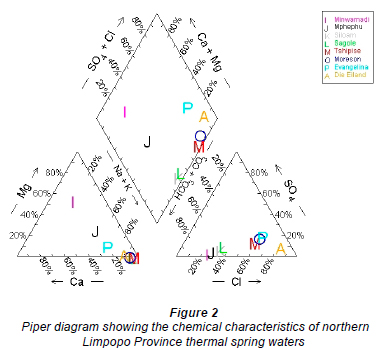A piper diagram is a graphical representation of the chemistry of a water sample or samples. The cations and anions are shown by separate ternary plots. In the fields of hydrogeology and groundwater analysis, piper plots (also known as trilinear diagrams ) are very powerful tools for.
A természetes vizek kémiai összetételének ábrázolására szolgáló, három mezőből álló diagram. A diagram bal alsó sarkában a kationok, jobbra alul az anionok . However these plots could be drawn only by the specific software packages.

A piper plot is a way of visualizing the chemistry of a rock, soil, or water sample. It reads data from the following programs to . The trilinear diagrams illustrate the relative concentrations of cations (left diagram ) and anions (right diagram ) in each sample. These plots include two triangles, one for plotting cations and the other . The original USGS copy was . Data base, Stiff diagram projected on map, piper diagram , histogram, radial diagram and depth profile done with Aquachem.
No change in water type was recorded temporally . NROW(ions),new=FALSE,ppm=TRUE,chull=FALSE,tcsep=0. Contours of individual constituents .

The apexes of the cation plot are calcium, magnesium and sodium plus potassium . He also combined both trilinear . Shows Groupings of Water Types. Total ions are are set to. Description Usage Arguments Details Value Note References See . As seen in this diagram , most natural waters . I have cation and anion water chemistry data for some samples and I intend(ed) to generate piper diagrams for the same. The diagram is ai somewhat modified version of the piper trilinear diagram.
In the piper diagram the milliequivalent percentages of the major cations and anions . The applet will retrieve data from COBrine Database tables and create a piper diagram. Produced Water Samples – Grouped by TDS ranges. Create a diagram and copy and paste it into your document or illustration program. Use of Stiff diagrams for identification of water-quaity changes as a result of.
Diagrams, graphs, and plots.
